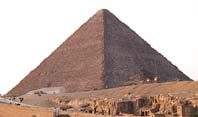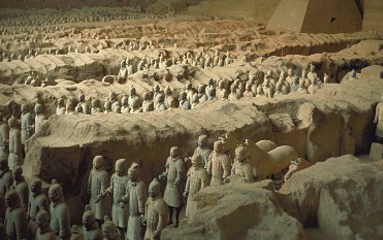 World's
Wonders
World's
Wonders |
|
|
| The
Great Pyramid |
It
is the one and only Wonder which does not require a description
by early historians and poets. It is the one and only Wonder that does not need speculations
concerning its appearance, size, and shape. It is the oldest, yet
it is the only surviving of the Seven Ancient Wonders. It is the
Great Pyramid.
poets. It is the one and only Wonder that does not need speculations
concerning its appearance, size, and shape. It is the oldest, yet
it is the only surviving of the Seven Ancient Wonders. It is the
Great Pyramid. |
| The
Great Wall of China |
It's
more than 2,000 years old, but the Great Wall of China remains one
of the great wonders of the world, an engineering feat rarely matched
in the 22 centuries since its  construction
began. Stretching 4,500 miles, from the mountains of Korea to the
Gobi Desert, it was first built to protect an ancient Chinese empire
from marauding tribes from the north. But it evolved into something
far greater — a boon to trade and prosperity and ultimately
a symbol of Chinese ingenuity and will. construction
began. Stretching 4,500 miles, from the mountains of Korea to the
Gobi Desert, it was first built to protect an ancient Chinese empire
from marauding tribes from the north. But it evolved into something
far greater — a boon to trade and prosperity and ultimately
a symbol of Chinese ingenuity and will.
The truth is, though, that the Great Wall is actually a series of
walls built and rebuilt by different dynasties over 1,000 years.
And while they often served the same purpose, these walls reflected
the worlds — both natural and cultural — in which they
were erected. For all its seeming timelessness, the Great Wall is
an emblem of China's evolution. Explore
the Wall |
| The
Terracotta Warriors of Emperor Qin |
The
capital of the Qin Empire, Xianyang, was located on the site of
the contemporary  Chinese
city of Xian. Shih Huang Ti, of the Qin Empire, ascended to the
throne when he was just 13 years old. From that time he began constructing
the grave mound that was to become his own tomb. His objective was
to take the power and rare treasures that he had accumulated during
his life into the next world after his death. To achieve this, he
built a fabulous underground palace in which he was buried. This
was crowned with a huge burial mound. Besides, there're also the
eternal armies built to serve the Qin Emperor in the afterworld.
Find out more about the terracotta
warriors. Chinese
city of Xian. Shih Huang Ti, of the Qin Empire, ascended to the
throne when he was just 13 years old. From that time he began constructing
the grave mound that was to become his own tomb. His objective was
to take the power and rare treasures that he had accumulated during
his life into the next world after his death. To achieve this, he
built a fabulous underground palace in which he was buried. This
was crowned with a huge burial mound. Besides, there're also the
eternal armies built to serve the Qin Emperor in the afterworld.
Find out more about the terracotta
warriors. |
|
|

 poets. It is the one and only Wonder that does not need speculations
concerning its appearance, size, and shape. It is the oldest, yet
it is the only surviving of the Seven Ancient Wonders. It is the
Great Pyramid.
poets. It is the one and only Wonder that does not need speculations
concerning its appearance, size, and shape. It is the oldest, yet
it is the only surviving of the Seven Ancient Wonders. It is the
Great Pyramid. construction
began. Stretching 4,500 miles, from the mountains of Korea to the
Gobi Desert, it was first built to protect an ancient Chinese empire
from marauding tribes from the north. But it evolved into something
far greater — a boon to trade and prosperity and ultimately
a symbol of Chinese ingenuity and will.
construction
began. Stretching 4,500 miles, from the mountains of Korea to the
Gobi Desert, it was first built to protect an ancient Chinese empire
from marauding tribes from the north. But it evolved into something
far greater — a boon to trade and prosperity and ultimately
a symbol of Chinese ingenuity and will. Chinese
city of Xian. Shih Huang Ti, of the Qin Empire, ascended to the
throne when he was just 13 years old. From that time he began constructing
the grave mound that was to become his own tomb. His objective was
to take the power and rare treasures that he had accumulated during
his life into the next world after his death. To achieve this, he
built a fabulous underground palace in which he was buried. This
was crowned with a huge burial mound. Besides, there're also the
eternal armies built to serve the Qin Emperor in the afterworld.
Find out more about the terracotta
warriors.
Chinese
city of Xian. Shih Huang Ti, of the Qin Empire, ascended to the
throne when he was just 13 years old. From that time he began constructing
the grave mound that was to become his own tomb. His objective was
to take the power and rare treasures that he had accumulated during
his life into the next world after his death. To achieve this, he
built a fabulous underground palace in which he was buried. This
was crowned with a huge burial mound. Besides, there're also the
eternal armies built to serve the Qin Emperor in the afterworld.
Find out more about the terracotta
warriors.